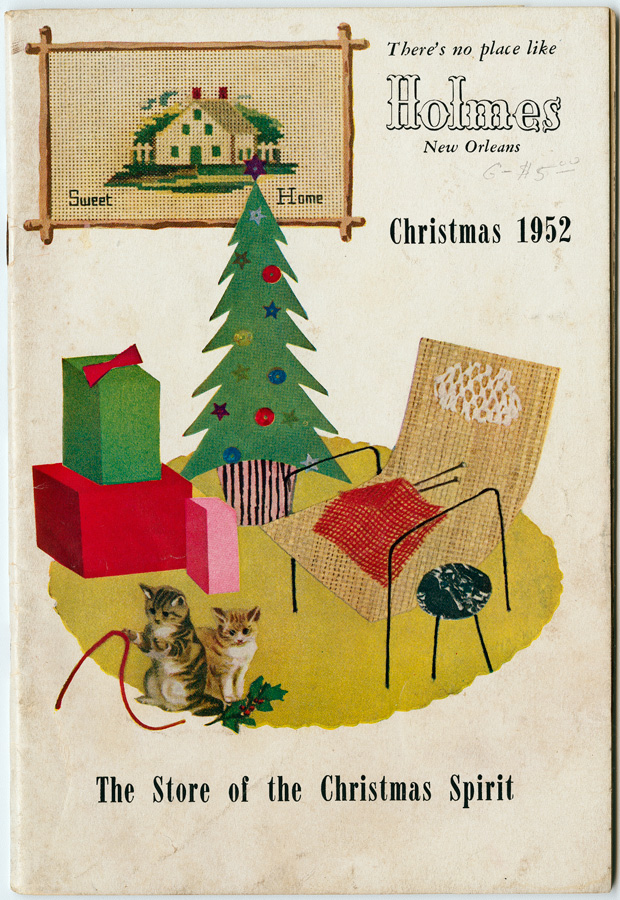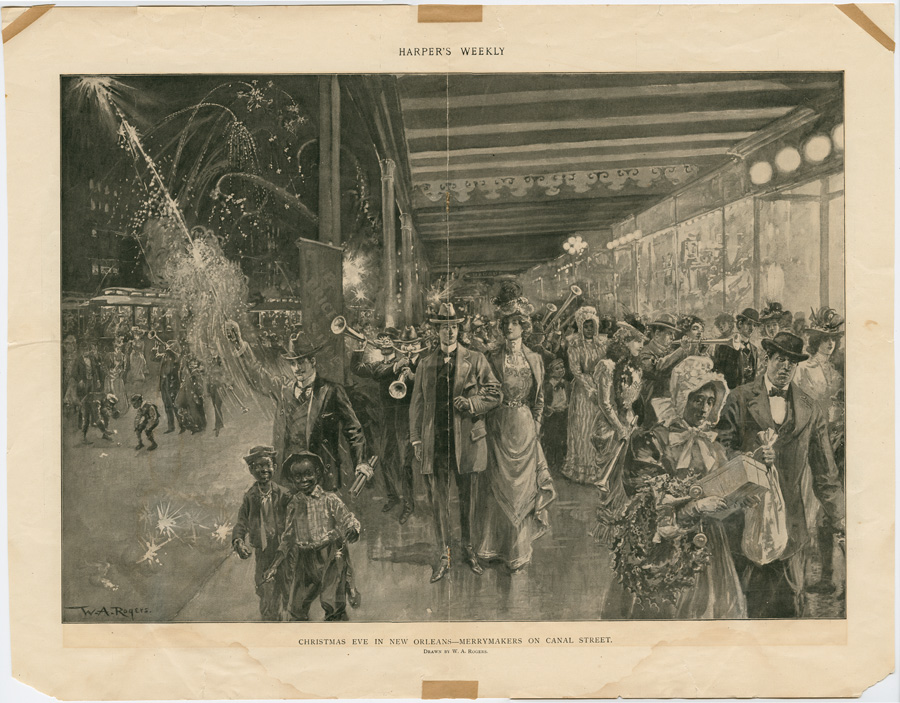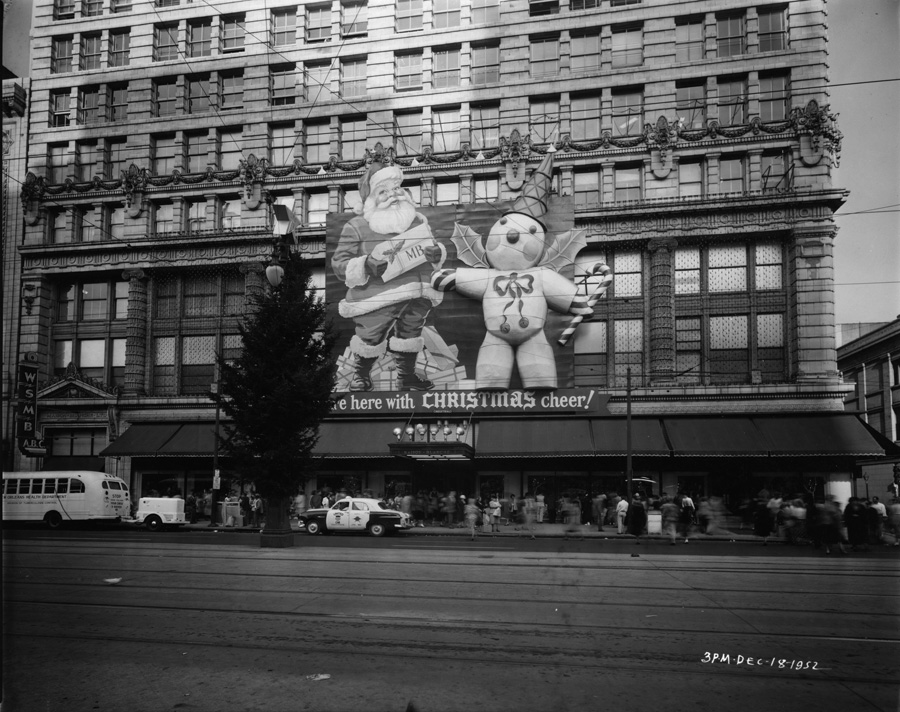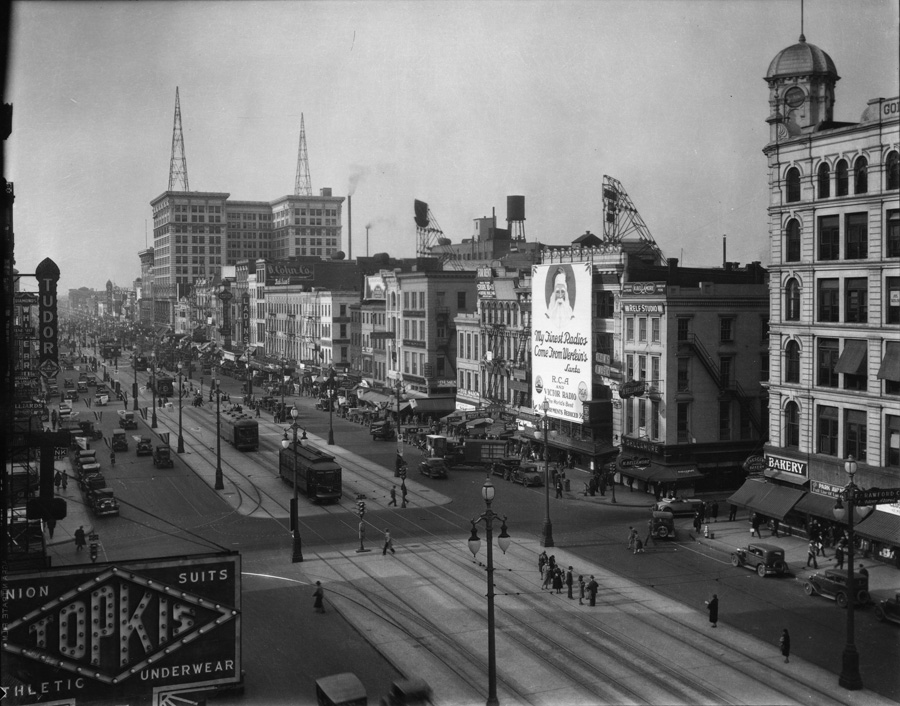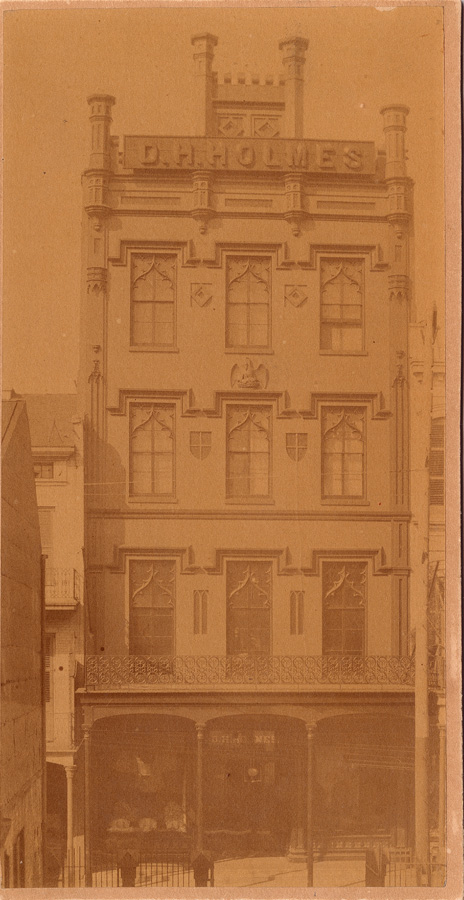November 07, 2012
Canal Street was New Orleans's premier shopping destination between about 1850 and 1990, and most New Orleanians have fond memories of Christmas shopping there. Though Canal Street - planned in 1810 as the site of a canal, which was never built - is not in the French Quarter, the two border each other, making the street a vital part of French Quarter retail history. For Christmas shoppers from other parts of town, the Quarter was an added Christmas attraction, since its many restaurants were ideal holiday lunch spots.
Lavish decorations, toy lands, trim-the-tree displays and aisles of Christmas cards enlivened the biggest department stores that lined the French Quarter side of Canal Street. The two most notable and usually most crowded were D. H. Holmes, which dated to 1842 and is now the Hyatt French Quarter Hotel, and Maison Blanche, established in 1897 and the site of today's Ritz-Carlton Hotel. Holmes and MB were across Dauphine Street from each other, and crowds of holiday shoppers rushed from one store to the other. A few blocks away were Krauss, another big store founded in 1903, now condominiums, and the smaller Marks Isaacs of 1919, now part of the Astor Hotel. Big five-and-dime stores S. H. Kress, W. T. Grant, and two different F. W. Woolworth's - one at Bourbon and one at Rampart - were other Christmas destinations on the French Quarter side. Most of these establishments stretched to Iberville Street, the real entrance to the French Quarter, and some extended even beyond it, with annexes between Iberville and Bienville.
A few specialty stores also populated the French Quarter side of Canal, like Werlein's music store, now the Palace Cafe, and Kreeger's, a women's fashion store at the corner of Bourbon. Most fashion stores were on the opposite side of the street between St. Charles and Baronne. Among leading women's stores were Gus Mayer at Carondelet, now a pharmacy, and Goldring's next door, while men shopped at Steven's, which dated from the 1870s, and Rubenstein's at the corner of St. Charles, still in business since 1924. Other defunct high-end Canal Street clothiers in the twentieth century included Mayer-Israel, Keller-Zander, and Godchaux's, which dated to 1842 and was reputedly the best store in town. Jewelers were abundant and Adler's, established in 1897, remains open on Canal and also has a Royal Street branch - Waldhorn and Adler. Less pricey shops on both sides of Canal stretched several blocks beyond Baronne Street.
Downtown also held good options for Christmas shoppers, especially the first blocks of Baronne - where a huge cutout Santa figure was mounted on the corner of Sears - as well as Carondelet and St. Charles. Jewelers like Leo Miller in the Roosevelt Hotel, Pailet and Penedo, and Bernard and Grunning were on Baronne, while Carondelet was known for men's stores, including Zoller's, Porter's, and Terry and Juden.
In the nineteenth and early twentieth centuries, Christmas shopping began on Christmas Eve - payday for many people - when stores remained open late and even opened early on Christmas. In New Orleans the shopping season went to New Year's Day, when French families traditionally gave gifts. Growing Americanization changed this, as the day after Thanksgiving eventually became the start of the shopping season. On this big shopping day, New Orleans traffic clogged downtown and French Quarter streets leading to Canal Street.
By the 1860s Santa Claus was wildly popular, and larger stores invariably included costumed Santas, which must have been confusing for children, since there would have been one in most stores on Canal Street. Holmes, MB and others in their growing emphasis on Christmas toy departments frequently gave Santa a gimmick, such as MB's wireless, which children could use to send messages to Santa's workshop at the North Pole in 1911.
Another enduring local holiday icon is Mr. Bingle, a marionette snowman created for Maison Blanche in 1947. He instantly caught on as part of the holiday season on Canal Street and was joined by several other characters in puppet shows that were performed in MB show windows. Mr. Bingle even starred in a television program promoting MB's toy department. A giant Mr. Bingle hung on the front of MB's gigantic 1908 building during the holidays for years until the store closed. Dillard's, which bought the Maison Blanche chain, donated the figure to City Park's Holiday in the Oaks. Damaged in Hurricane Katrina's flood in 2005, Mr. Bingle was restored in time for that year's reduced celebrations, and he remains as much a part of Christmas in New Orleans as Santa Claus.
Late nineteenth and early twentieth century Christmas on Canal Street went beyond shopping. Dense crowds filled the street on Christmas Eve, many coming to promenade and see electric lights garlanded along the street and around buildings. Canal Street window decorators vied to outdo each other, as they filled show windows that were ablaze with light - gas illumination in the early days then electric lights beginning in the 1880s. Sidewalk vendors sold anything from cheap jewelry and silk flowers to birds to fireworks. Making noise - blowing horns, beating drums, and shooting fireworks and even guns - was a hallmark of Christmas in the Crescent City. By the 1920s Christmas had become more sedate, and such rowdy merrymaking was reserved for New Year's Eve and Mardi Gras. Later twentieth-century Christmas show windows evolved into lush story-land displays that were generally not revealed until the day after Thanksgiving. The finest window displays in New Orleans were the animated wonderlands at D. H. Holmes, for which families made special holiday trips downtown.
Today most Christmas shopping has moved from the Canal Street shopping district to suburban malls or in-town destinations like Magazine Street, Canal Place, and the French Quarter, with its own shops and festive holiday events. In spite of this Canal Street is still decorated during the holidays with greens and tiny lights garlanding palm trees and light standards that hark back to nineteenth century electric light displays and the street's heyday.
Lavish decorations, toy lands, trim-the-tree displays and aisles of Christmas cards enlivened the biggest department stores that lined the French Quarter side of Canal Street. The two most notable and usually most crowded were D. H. Holmes, which dated to 1842 and is now the Hyatt French Quarter Hotel, and Maison Blanche, established in 1897 and the site of today's Ritz-Carlton Hotel. Holmes and MB were across Dauphine Street from each other, and crowds of holiday shoppers rushed from one store to the other. A few blocks away were Krauss, another big store founded in 1903, now condominiums, and the smaller Marks Isaacs of 1919, now part of the Astor Hotel. Big five-and-dime stores S. H. Kress, W. T. Grant, and two different F. W. Woolworth's - one at Bourbon and one at Rampart - were other Christmas destinations on the French Quarter side. Most of these establishments stretched to Iberville Street, the real entrance to the French Quarter, and some extended even beyond it, with annexes between Iberville and Bienville.
A few specialty stores also populated the French Quarter side of Canal, like Werlein's music store, now the Palace Cafe, and Kreeger's, a women's fashion store at the corner of Bourbon. Most fashion stores were on the opposite side of the street between St. Charles and Baronne. Among leading women's stores were Gus Mayer at Carondelet, now a pharmacy, and Goldring's next door, while men shopped at Steven's, which dated from the 1870s, and Rubenstein's at the corner of St. Charles, still in business since 1924. Other defunct high-end Canal Street clothiers in the twentieth century included Mayer-Israel, Keller-Zander, and Godchaux's, which dated to 1842 and was reputedly the best store in town. Jewelers were abundant and Adler's, established in 1897, remains open on Canal and also has a Royal Street branch - Waldhorn and Adler. Less pricey shops on both sides of Canal stretched several blocks beyond Baronne Street.
Downtown also held good options for Christmas shoppers, especially the first blocks of Baronne - where a huge cutout Santa figure was mounted on the corner of Sears - as well as Carondelet and St. Charles. Jewelers like Leo Miller in the Roosevelt Hotel, Pailet and Penedo, and Bernard and Grunning were on Baronne, while Carondelet was known for men's stores, including Zoller's, Porter's, and Terry and Juden.
In the nineteenth and early twentieth centuries, Christmas shopping began on Christmas Eve - payday for many people - when stores remained open late and even opened early on Christmas. In New Orleans the shopping season went to New Year's Day, when French families traditionally gave gifts. Growing Americanization changed this, as the day after Thanksgiving eventually became the start of the shopping season. On this big shopping day, New Orleans traffic clogged downtown and French Quarter streets leading to Canal Street.
By the 1860s Santa Claus was wildly popular, and larger stores invariably included costumed Santas, which must have been confusing for children, since there would have been one in most stores on Canal Street. Holmes, MB and others in their growing emphasis on Christmas toy departments frequently gave Santa a gimmick, such as MB's wireless, which children could use to send messages to Santa's workshop at the North Pole in 1911.
Another enduring local holiday icon is Mr. Bingle, a marionette snowman created for Maison Blanche in 1947. He instantly caught on as part of the holiday season on Canal Street and was joined by several other characters in puppet shows that were performed in MB show windows. Mr. Bingle even starred in a television program promoting MB's toy department. A giant Mr. Bingle hung on the front of MB's gigantic 1908 building during the holidays for years until the store closed. Dillard's, which bought the Maison Blanche chain, donated the figure to City Park's Holiday in the Oaks. Damaged in Hurricane Katrina's flood in 2005, Mr. Bingle was restored in time for that year's reduced celebrations, and he remains as much a part of Christmas in New Orleans as Santa Claus.
Late nineteenth and early twentieth century Christmas on Canal Street went beyond shopping. Dense crowds filled the street on Christmas Eve, many coming to promenade and see electric lights garlanded along the street and around buildings. Canal Street window decorators vied to outdo each other, as they filled show windows that were ablaze with light - gas illumination in the early days then electric lights beginning in the 1880s. Sidewalk vendors sold anything from cheap jewelry and silk flowers to birds to fireworks. Making noise - blowing horns, beating drums, and shooting fireworks and even guns - was a hallmark of Christmas in the Crescent City. By the 1920s Christmas had become more sedate, and such rowdy merrymaking was reserved for New Year's Eve and Mardi Gras. Later twentieth-century Christmas show windows evolved into lush story-land displays that were generally not revealed until the day after Thanksgiving. The finest window displays in New Orleans were the animated wonderlands at D. H. Holmes, for which families made special holiday trips downtown.
Today most Christmas shopping has moved from the Canal Street shopping district to suburban malls or in-town destinations like Magazine Street, Canal Place, and the French Quarter, with its own shops and festive holiday events. In spite of this Canal Street is still decorated during the holidays with greens and tiny lights garlanding palm trees and light standards that hark back to nineteenth century electric light displays and the street's heyday.

